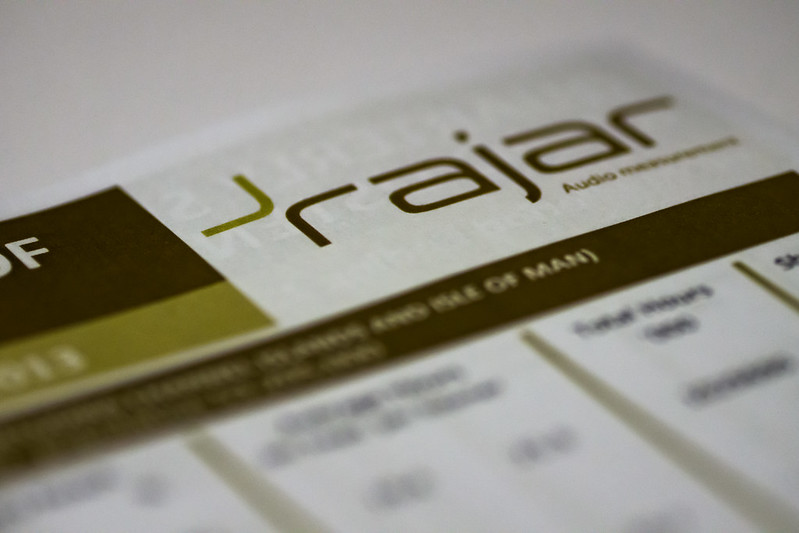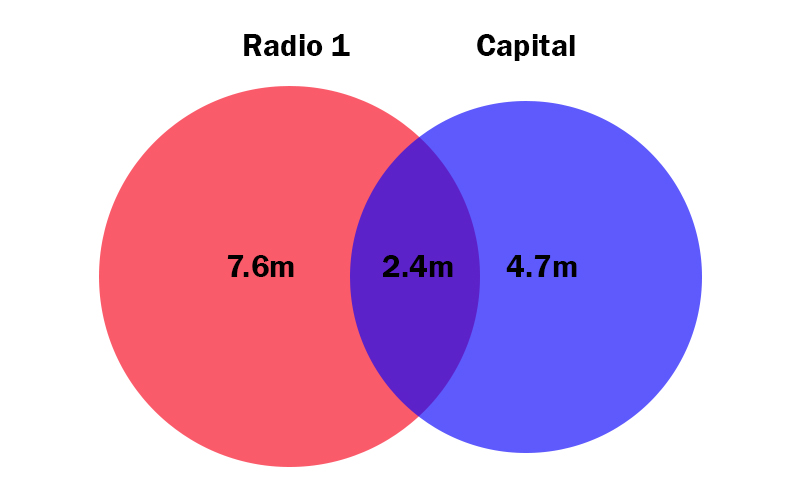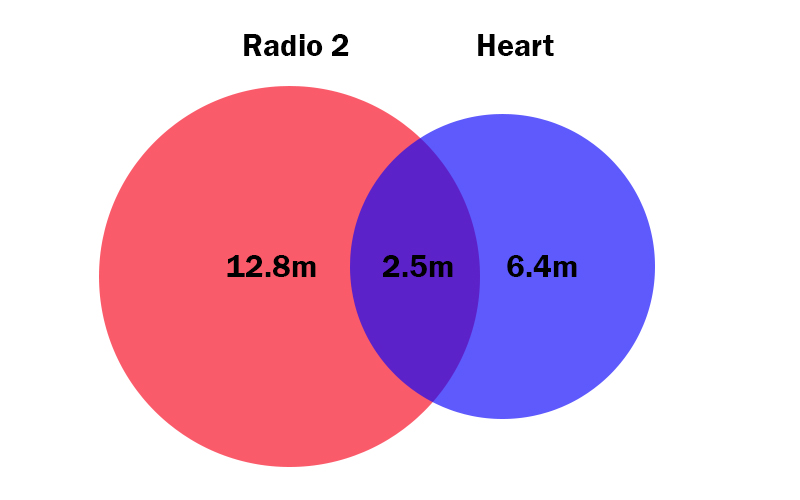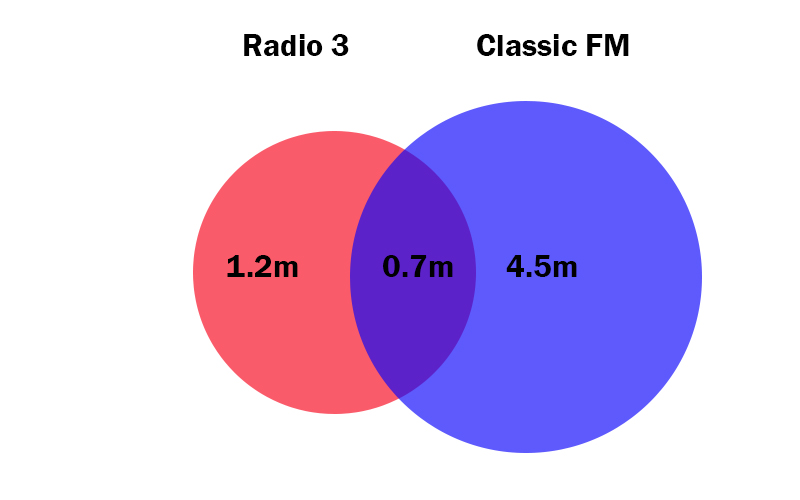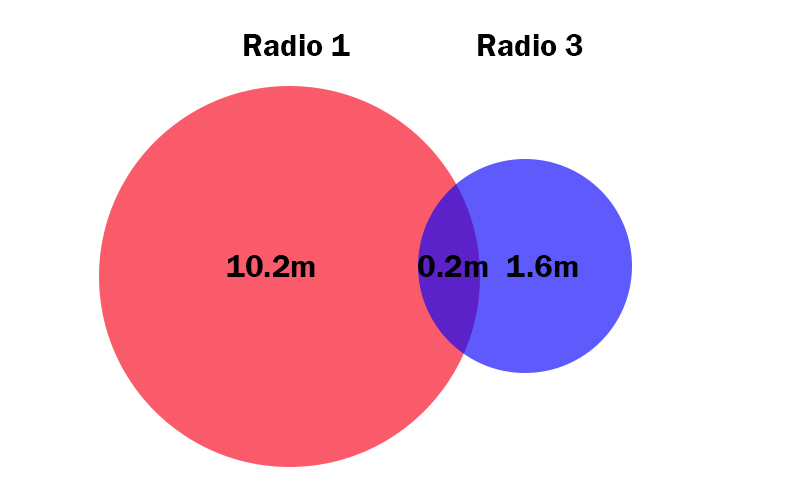This post is brought to you in association with RALF from DP Software and Services. I’ve used RALF for the past 8 years, and it’s my favourite RAJAR analysis tool. So I’m delighted to be able to bring you this analysis. For more details on RALF, contact Deryck Pritchard via this link or phone 07545 425677.
The first thing to say is that this has been a good quarter for radio as a whole. Overall reach is back to 90%, and listening hours have increased too, with the average radio listener listening for 21.7 hours a week – the highest in a couple of years.
Commercial radio is likely to be pleased too, since it has gained back a little from the BBC, with 44.4% of listening being commercial (up from 42.8% last quarter), compared with 53.0% to the BBC (down from 54.4% last quarter). Commercial has gained too, compared with this time last year.
And because it’s always keenly watched, the number of people who listen via a digital platform at least some point during the week has grown to over 60% of the population for the first time (61.1% up from 59.8% last quarter). The amount of listening via those platforms has also grown – up to 39.9% of all listening.
Let’s look in a bit more detail at the performances of some of the key players.
National Stations
Radio 1 has notably bounced back since last quarter’s results. Indeed those previous numbers do now look a little of an aberration, and are a reminder that nobody should ever judge a station’s figures on the basis of a single RAJAR period. The station’s reach has increased by 7.6% and is back over 10 million, while hours have increased by 3.3% on the previous quarter. It’s true that they’re still down on the previous year, but I think they’d take these numbers.
Radio 2 has also improved from last quarter a fraction – but you would probably argue it’s results are flat. Still not bad for the biggest station in the UK/Europe/World/Universe (Delete as applicable).
Radio 3 has dropped below 2m again, although it’ll undoubtedly return next quarter (Proms), but its listening hours are up nearly 5% (and enormously on the previous year).
Here’s an interesting question: who do you think has the higher average age? Radio 3 or Radio 4?
In fact, the average age of a Radio 3 listener is 57, and that of a Radio 4 listener is 56. The variability of those averages is probably quite different however.
Radio 4 fell marginally this quarter, although it’s up on the previous year and still reaches 10.6m people a week.
Five Live is still clearly finding its feet following all its schedule changes, and is back down this quarter – 7.6% down in reach, but only 2.4% down in hours. That does leave it well down on the previous year however. And there’s not really a big summer of sport to help get things straightened out, so it’ll be worth watching.
Classic FM will be disappointed with its results. It’s reach and hours are both down on the quarter and the year, with reach in particular at an all time low under the current RAJAR methodology (so since 1999). It still reaches nearly 5.3m people, but it’s something to keep an eye on. There can be a bitter war of words between it and Radio 3, when they think the latter is dumbing down to appeal to Classic FM’s audience. But Classic FM’s audience is 2.5x Radio 3’s, and as we’ve established, Radio 3’s audience fell this quarter too.
Talksport will also be disappointed by this set of results, which include the end of the football season. Both reach and hours are down on the previous quarter, and over 10% down on the previous year. It’s reach still hovers above 3m, while hours are above 20m. It’ll be hoping that the forthcoming sister services which are due to launch next year on D2 will help grow a “Talk” network.
Meanwhile the main Absolute Radio station has seen its reach stay flat while hours have grown – quite substantially on the year. With the station due to take over the West Midlands FM licence currently used to broadcast Planet Rock, it should mean some further growth in the coming quarters (although such format switches always take time to bed in locally).
National Digital Stations
Overall Bauer has had a very good quarter with several of its brands achieving record audiences.
The Absolute Radio Network now reaches a record high of 4.04m people a week with just less than 32m hours. And that’s without including Planet Rock’s figures with which it is bundled when sold. That comes off the back of yet more growth on Absolute 80s which jumped another 10.7% in reach on the previous quarter, and much more on the previous year. At 1.6m reach, it’s getting ever closer to the 2.0m that the main brand gets. (I remain uncertain as to the plan to move Absolute 80s off D1 and onto D2 at launch, since the lower reach of the new multiplex must surely effect these numbers negatively. We’ll have to wait and see).
The Kiss Network has also achieved some great growth with over 5m reach and 30.5m hours – both records. These are helped especially by some very significant improvements in Kisstory which has seen nearly a 30% increase in reach and a more than 40m increase in hours. And Kisstory has yet to launch properly nationally on DAB, currently only appearing on a series on local DAB multiplexes.
The nascent Magic Network also did well. It too has a sister station due with D2.
Global Radio has perhaps more of a mixed bag this quarter.
The Capital Brand has increased in reach and hours this quarter – a modest 1.9% in reach, but a more chunky 9.7% in hours. But both are down on the previous year.
Heart is more disappointing. Overall it’s down 1.4% in reach and 6.8% in hours, with both measures down on the year too. It’s also not clear when the previously announced Heart Extra is likely to launch which might help prop up the brand a little. It was announced in December last year, but the presumed spot on the D1 multiplex was retained by Premier Christian Radio after negotiations with multiplex operator (Premier has signed up until 2028 according to reports).
Smooth has also shown some disappointing results this quarter, down in reach and hours, although not as bad on the year. While Xfm is flat in reach, but down further in hours – another 7% down on the quarter and 12% down on the year. The radio industry is currently awash with rumours that Chris Moyles is going to Xfm, which may even get a full rebrand and relaunch. We’ll have to see.
LBC has had some very strong results, with its reach up strongly on both the quarter and the year. The station is now showing some real growth since it went national towards the start of last year. We could be in for some interesting battles between LBC and Talkradio once it launches.
It feels like every quarter that I report that 6 Music has had a record reach. Well it hasn’t this quarter – it’s actually down by a paltry 9,000 listeners. But it’s had record hours. With its listeners spending 9.1 hours a week, this is not an “additional” station, this is very much a main station for those 2m people.
1Xtra has had a strong quarter, up a lot in reach (14.2%) and an enormous amount in listening hours (47%). This probably reflects a bit of freak set of results last quarter as much as anything though.
Radio 4 Extra had extraordinarily high results last quarter, so perhaps unsurprisingly it has fallen – back below 2m listeners. It is still well up on the previous year though (+25% in reach and +37% in hours), so I’d say that it’s still a confidently growing station.
And it’s been a very strong result for 5 Live Sports Extra – even in a period before The Ashes began (although there was other cricket). Reach is up 21% and hours are up nearly 50%! Even though this represents a record high reach, I would expect both figures to increase further with the current Ashes campaign driving them.
Finally, since it’s very close to home for me now, I should report that listening to the BBC World Service is up very a very solid 14% in reach on the quarter and a similar amount on the year. Hours are a more modest 3% up.
London Stations
While I’m sure some readers think that London radio gets too much attention paid to it, I always think as much as anything it’s worth paying to attention to because it’s proved a good indicator of where radio is heading in the UK as a whole. It’s obviously of key importance to agencies buying advertising on commercial stations as well.
The figures this quarter show that all radio listening is at 89% (up from 86%) which compares well with 90% overall. What that means is that although Spotify, Apple Music and everyone else is fighting it out for supremacy, it’s not had a massive impact on radio… at least not yet. Indeed radio listening in London is up 9.4% on the previous quarter too, with radio listeners in London spending an average of 20.5 hours listening to the radio every week. So perhaps last quarter’s numbers were a one-off?
Interestingly, most of that growth this quarter has come from commercial radio with the BBC broadly flat in reach, and up 2.8% in hours. It’s also worth pointing out that in London, unlike nationally, commercial radio is more listened to than the BBC, with 51.0% of listening compared with the BBC’s 45.6%.
That all said, Radio 4 remains the most listened to station in the capital, but you’re really interested in the battle between the commercial stations aren’t you?
I think the big London news is that Global has had a great quarter. Capital has scored its highest reach in quite a while, jumping 22.7%. And it’s hours are also up 20.7%. That gives Capital the number one commercial spot in London, as it just beats Kiss. The 80,000 difference between the two is about the number of people who get to go to Capital’s Summertime Ball! Its sister brand Capital Xtra has also done well – up to such a great extent, that we know that last quarter’s data probably shouldn’t even be looked at.
Heart too seems to be back from a recent slump, jumping nearly 30% in reach to close to 2m. Hours growth is more modest, but it’s back over 10m.
Meanwhile it turns out that Xfm isn’t dead in London, and Smooth too is turning it around.
LBC is again a strong performer, and its listening hours shouldn’t be underestimated – it’s number two in London under that measure.
But number one in hours is Bauer’s Kiss which has also had a very strong reach performance jumping to 2.12m – its highest ever. It’s hours were up 26% on the quarter and reach up 12.6%. With Magic putting in some solid growth in reach and hours, only Absolute Radio’s London performance will have disappointed them a little (down in reach and hours on the quarter although up on the year).
Breakfast
I’m not going to dwell long on this and just consider Radio 1 and Radio 2, since both presenters have some interesting new TV jobs coming up and it’ll be worth seeing whether it makes any difference to their ratings over the coming months.
Nick Grimshaw takes on co-presenting duties of The X-Factor later this month, and this quarter has seen his reach increase by 6.2% to 5.8m. While Chris Moyles has previously had in excess of 7m listeners for the Radio 1 breakfast show, we’ve not seen numbers like that since the start of 2012. The other thing to watch here would be any kind of “Moyles effect” should he show up on Xfm, and should Xfm be given a significant marketing budget and be made available nationally on DAB. Lots of ifs there. And it’s been a while since Moyles was on the radio, so where are those listeners now? Nothing is certain.
Meanwhile Chris Evans on Radio 2 has also had a decent set of results with increase in reach and hours. While neither are quite records, you’d have to go back to the start of 2012 to find the last time listeners spent so much time with Radio 2’s breakfast show. Evans of course, is taking over Top Gear from next year. And there’s also another run of TFI Friday planned. Can he keep all this up and his Radio 2 show? We’ll have to see.
No bubbles this quarter I’m afraid. Hopefully they’ll be back next time.
But instead, I thought I’d show you some audience overlap figures between some station pairings. Broadly speaking radio listeners hear fewer stations than TV viewers watch stations. But there are overlaps between services, and it’s always worth having a look to see who listens to otherwise similar stations – and who doesn’t.
Radio 1 v Capital Network
So just to explain this chart, it means that 2.4m people listen to both Radio 1 and Capital, while 7.6m Radio 1 listeners never listen to Capital, and 4.7m Capital listeners never listen to Radio 1 (At least across a single week).
Radio 2 v Heart (Network)
Radio 3 v Classic FM
Five Live v Talksport
Radio 1 v Radio 3
Well – there was a Radio 1 Prom this year!
NB. These charts are not necessarily quite to scale – I “hand” drew them in Photoshop.
Further Reading
For more RAJAR analysis, I’d recommend the following sites:
The official RAJAR site and their infographic probably here
Radio Today for a digest of all the main news
Go to Media.Info for lots of numbers and charts
Paul Easton for analysis including London
Matt Deegan usually has some analysis
Media Guardian for more news and coverage
The BBC Mediacentre for BBC Radio stats and findings
Sadly the One Golden Square blog seems to have died, but you could try Bauer Media’s site.
And it’s entirely likely you’ll find Global Radio here.
Source: RAJAR/Ipsos-MORI/RSMB, period ending 28 June 2015, Adults 15+. One other thing to note is that RAJAR updates its population estimates in Q2 each year, so we’ve seen the UK adult population grow slightly this quarter, although only by 1.3% nationally.
Disclaimer: These are my views alone and do not represent those of anyone else, including my employer. Any errors (I hope there aren’t any!) are mine alone. Drop me a note if you want clarifications on anything. Access to the RAJAR data is via RALF from DP Software as mentioned at the top of this post.

